Holistic Approach to Design, Test, and Optimize Stand-Alone SOFC-Reformer Systems
Abstract
1. Introduction
2. Simulation
2.1. Reformer Modelling
2.2. Equilibrium Calculations
3. Experimental Setup
3.1. Methane Reforming
3.2. Single Cell Tests
4. Results and Discussion
4.1. Reformer Model Validation
4.1.1. Temperature Profile Validation
4.1.2. Equilibrium Composition Validation
4.2. Cell Performance and Characterization
4.3. Investigation of SOFC Degradation
5. Conclusions and Outlook
Author Contributions
Funding
Informed Consent Statement
Data Availability Statement
Acknowledgments
Conflicts of Interest
Abbreviations
| AC | Alternating current |
| AOGR | Anode off gas recycling |
| ATR | Auto-thermal reforming |
| Comp. | Composition |
| DC | Direct current |
| DRT | Distribution of relaxation times |
| EDX | Energy dispersive X-ray spectroscopy |
| EIS | Electrochemical impedance spectroscopy |
| ESC | Electrolyte supported cell |
| EU | European Union |
| GHSV | Gas hourly space velocity |
| H2O/C | Steam to carbon ratio |
| HPLC | high pressure liquid chromatography |
| ICE | Internal combustion engine |
| KK | Kramers-Kronig |
| LSCF | Lanthanum strontium cobalt ferrite |
| MFC | Mass flow controller |
| O2/C | Oxygen to carbon ratio |
| ScSZ | Scandia stabilized zirconium |
| SEM | Scanning electron microscopy |
| SOFC | Solid oxide fuel cell |
| TPB | Triple phase boundary |
| WGS | Water gas shift |
| YSZ | Yttrium stabilized zirconium |
References
- Eurostat. Technical report 2018. Available online: http://ec.europa.eu/eurostat/statisticsexplained/ (accessed on 25 November 2020).
- Göll, S.; Samsun, R.; Peters, R. Analysis and optimization of solid oxide fuel cell-based auxiliary power units using a generic zero-dimensional fuel cell model. J. Power Sources 2011, 196, 9500–9509. [Google Scholar] [CrossRef]
- Dong, S.; Yun, B.; Lee, D. Design and numerical study for l kW tubular SOFC APU system. ECS Trans. 2008, 12, 701–706. [Google Scholar] [CrossRef]
- Song, C. Fuel processing for low-temperature and high-temperature fuel cells: Challenges, and opportunities for sustainable development in the 21st century. Catal. Today 2002, 77, 17–49. [Google Scholar] [CrossRef]
- Stoeckl, B.; Subotić, V.; Preininger, M.; Schwaiger, M.; Evic, N.; Schroettner, H.; Hochenauer, C. Characterization and performance evaluation of ammonia as fuel for solid oxide fuel cells with Ni/YSZ anodes. Electrochim. Acta 2019, 298, 874–883. [Google Scholar] [CrossRef]
- Stoeckl, B.; Subotić, V.; Preininger, M.; Schroettner, H.; Hochenauer, C. SOFC operation with carbon oxides: Experimental analysis of performance and degradation. Electrochim. Acta 2018, 275, 256–264. [Google Scholar] [CrossRef]
- Schluckner, C.; Subotić, V.; Lawlor, V.; Hochenauer, C. Three-dimensional numerical and experimental investigation of an industrial-sized SOFC fueled by diesel reformat—Part I: Creation of a base model for further carbon deposition modeling. Int. J. Hydrog. Energy 2014, 39, 19102–19118. [Google Scholar] [CrossRef]
- Subotić, V.; Baldinelli, A.; Barelli, L.; Scharler, R.; Pongratz, G.; Hochenauer, C.; Anca-Couce, A. Applicability of the SOFC technology for coupling with biomass-gasifier systems: Short- and long-term experimental study on SOFC performance and degradation behaviour. Appl. Energy 2019, 256, 113904. [Google Scholar] [CrossRef]
- Pongratz, G.; Subotić, V.; Schroettner, H.; Stoeckl, B.; Hochenauer, C.; Anca-Couce, A.; Scharler, R. Investigation of solid oxide fuel cell operation with synthetic biomass gasification product gases as a basis for enhancing its performance. Biomass Convers. Biorefinery 2020. [Google Scholar] [CrossRef]
- Abdelkareem, M.A.; Tanveer, W.H.; Sayed, E.T.; Assad, M.E.H.; Allagui, A.; Cha, S.W. On the technical challenges affecting the performance of direct internal reforming biogas solid oxide fuel cells. Renew. Sustain. Energy Rev. 2019. [Google Scholar] [CrossRef]
- Subotić, V.; Schluckner, C.; Hochenauer, C. An experimental and numerical study of performance of large planar ESC-SOFCs and experimental investigation of carbon depositions. J. Energy Inst. 2016, 89, 121–137. [Google Scholar] [CrossRef]
- Hänggi, S.; Elbert, P.; Bütler, T.; Cabalzar, U.; Teske, S.; Bach, C.; Onder, C. A review of synthetic fuels for passenger vehicles. Energy Rep. 2019, 5, 555–569. [Google Scholar] [CrossRef]
- Pasel, J.; Samsun, R.C.; Meißner, J.; Tschauder, A.; Peters, R. Recent advances in diesel autothermal reformer design. Int. J. Hydrog. Energy 2019. [Google Scholar] [CrossRef]
- Yoon, S.; Lee, S.; Bae, J. Development of a self-sustaining kWe-class integrated diesel fuel processing system for solid oxide fuel cells. Int. J. Hydrog. Energy 2011, 36, 10302–10310. [Google Scholar] [CrossRef]
- Boon, J.; Van Dijk, E.; De Munck, S.; Van Den Brink, R. Steam reforming of commercial ultra-low sulphur diesel. J. Power Sources 2011. [Google Scholar] [CrossRef]
- Souza, A.E.; MacIel, L.J.; Cavalcanti-Filho, V.O.; Filho, N.M.; Abreu, C.A. Kinetic-operational mechanism to autothermal reforming of methane. Ind. Eng. Chem. Res. 2011, 50, 2585–2599. [Google Scholar] [CrossRef]
- Badmaev, S.; Akhmetov, N.; Belyaev, V.; Kulikov, A.; Pechenkin, A.; Potemkin, D.; Konishcheva, M.; Rogozhnikov, V.; Snytnikov, P.; Sobyanin, V. Syngas production via partial oxidation of dimethyl ether over Rh/Ce0.75Zr0.25O2 catalyst and its application for SOFC feeding. Int. J. Hydrog. Energy 2020. [Google Scholar] [CrossRef]
- Loukou, A.; Mendes, M.A.; Frenzel, I.; Pereira, J.M.; Ray, S.; Pereira, J.C.; Trimis, D. Experimental and numerical investigation of methane thermal partial oxidation in a small-scale porous media reformer. Int. J. Hydrog. Energy 2017, 42, 652–663. [Google Scholar] [CrossRef]
- Subotić, V.; Pofahl, S.; Lawlor, V.; Menzler, N.; Thaller, T.; Hochenauer, C. Online monitoring tools for SoH diagnostic and prognostic of remaining lifetime of reversible solid oxide cell (rSOC) systems. Energy Procedia 2019, 158, 2329–2334. [Google Scholar] [CrossRef]
- Zhang, H.; Liu, W.; Wang, Y.; Wang, J.; Yang, J.; Liang, T.; Yin, C.; Chi, B.; Jia, L.; Guan, W. Performance and long-term durability of direct-methane flat-tube solid oxide fuel cells with symmetric double-sided cathodes. Int. J. Hydrog. Energy 2019, 44, 28947–28957. [Google Scholar] [CrossRef]
- Trabold, T.; Lylak, J.; Walluk, M.; Lin, J.; Troiani, D. Measurement and analysis of carbon formation during diesel reforming for solid oxide fuel cells. Int. J. Hydrog. Energy 2012, 37, 5190–5201. [Google Scholar] [CrossRef]
- Kupecki, J.; Wierzbicki, M.; Jagielski, S.; Kluczowski, R.; Motylinski, K.; Skrzypkiewicz, M. Preliminary Long-Term Experimental Characterization of a Solid Oxide Fuel Cell Operated in DIR-SOFC Mode. ECS Trans. 2019, 91, 471–477. [Google Scholar] [CrossRef]
- Watanabe, H.; Okino, R.; Hanamura, K. Structural evolution of carbon deposition on a Ni/YSZ cermet of a SOFC analyzed by soft x-ray XANES spectroscopy. Int. J. Hydrog. Energy 2019, 44, 24028–24035. [Google Scholar] [CrossRef]
- Subotić, V.; Menzler, N.H.; Lawlor, V.; Fang, Q.; Pofahl, S.; Harter, P.; Schroettner, H.; Hochenauer, C. On the origin of degradation in fuel cells and its fast identification by applying unconventional online-monitoring tools. Appl. Energy 2020, 277, 115603. [Google Scholar] [CrossRef]
- Stoeckl, B.; Subotić, V.; Reichholf, D.; Schroettner, H.; Hochenauer, C. Extensive analysis of large planar SOFC: Operation with humidified methane and carbon monoxide to examine carbon deposition based degradation. Electrochim. Acta 2017, 256, 325–336. [Google Scholar] [CrossRef]
- Subotic, V.; Stoeckl, B.; Schluckner, C.; Pofahl, S.; Lawlor, V.; Schroettner, H.; Hochenauer, C. Development of cell-protecting methods for carbon-removal from porous Ni-YSZ anodes and regeneration of the cell performance. ECS Trans. 2017, 78, 2441–2449. [Google Scholar] [CrossRef]
- Girona, K.; Laurencin, J.; Fouletier, J.; Lefebvre-Joud, F. Carbon deposition in CH4/CO2 operated SOFC: Simulation and experimentation studies. J. Power Sources 2012, 210, 381–391. [Google Scholar] [CrossRef]
- Lee, Y.; Hanna, J.; Ghoniem, A.F. On the Predictions of Carbon Deposition on the Nickel Anode of a SOFC and Its Impact on Open-Circuit Conditions. J. Electrochem. Soc. 2013, 160, 94–105. [Google Scholar] [CrossRef]
- Subotić, V.; Harter, P.; Stoeckl, B.; Preininger, M.; Kusnezoff, M.; Lawlor, V.; Pofahl, S.; Napporn, T.; Megel, S.; Schroettner, H.; et al. Fast fuel variation and identification of SOFC system changes using online health monitoring tools and fault diagnosis. ECS Trans. 2019, 91, 753–759. [Google Scholar] [CrossRef]
- Haga, K.; Adachi, S.; Shiratori, Y.; Itoh, K.; Sasaki, K. Poisoning of SOFC anodes by various fuel impurities. Solid State Ionics 2008, 179, 1427–1431. [Google Scholar] [CrossRef]
- Sasaki, K.; Haga, K.; Yoshizumi, T.; Minematsu, D.; Yuki, E.; Liu, R.; Uryu, C.; Oshima, T.; Ogura, T.; Shiratori, Y.; et al. Chemical durability of Solid Oxide Fuel Cells: Influence of impurities on long-term performance. J. Power Sources 2011. [Google Scholar] [CrossRef]
- Sasaki, K.; Teraoka, Y. Equilibria in fuel cell gases. I. Equilibrium compositions and reforming conditions. J. Electrochem. Soc. 2003, 150. [Google Scholar] [CrossRef]
- Sasaki, K.; Teraoka, Y. Equilibria in Fuel Cell Gases II. The C-H-O Ternary Diagrams. J. Electrochem. Soc. 2003. [Google Scholar] [CrossRef]
- Liu, M.; Lanzini, A.; Halliop, W.; Cobas, V.R.; Verkooijen, A.H.; Aravind, P.V. Anode recirculation behavior of a solid oxide fuel cell system: A safety analysis and a performance optimization. Int. J. Hydrog. Energy 2013. [Google Scholar] [CrossRef]
- Neidhardt, J.; Henke, M.; Bessler, W.G. Kinetic Modeling of Nickel Oxidation in SOFC Anodes. ECS Trans. 2011, 35, 1621–1629. [Google Scholar] [CrossRef]
- Neidhardt, J.; Kee, R.; Bessler, W. Electrode reoxidation in solid-oxide cells: Detailed modeling of nickel oxide film growth. ECS Trans. 2013, 57, 2573–2582. [Google Scholar] [CrossRef]
- Neidhardt, J.P.; Bessler, W.G. Microkinetic Modeling of Nickel Oxidation in Solid Oxide Cells: Prediction of Safe Operating Conditions. Chemie-Ingenieur-Technik 2019, 91, 843–855. [Google Scholar] [CrossRef]
- Vaßen, R.; Simwonis, D.; Stöver, D. Modelling of the agglomeration of Ni-particles in anodes of solid oxide fuel cells. J. Mater. Sci. 2001, 36, 147–151. [Google Scholar] [CrossRef]
- Khan, M.S.; Lee, S.B.; Song, R.H.; Lee, J.W.; Lim, T.H.; Park, S.J. Fundamental mechanisms involved in the degradation of nickel-yttria stabilized zirconia (Ni-YSZ) anode during solid oxide fuel cells operation: A review. Ceram. Int. 2016. [Google Scholar] [CrossRef]
- Subotić, V.; Stoeckl, B.; Lawlor, V.; Strasser, J.; Schroettner, H.; Hochenauer, C. Towards a practical tool for online monitoring of solid oxide fuel cell operation: An experimental study and application of advanced data analysis approaches. Appl. Energy 2018. [Google Scholar] [CrossRef]
- Xia, J.; Wang, C.; Wang, X.; Bi, L.; Zhang, Y. A perspective on DRT applications for the analysis of solid oxide cell electrodes. Electrochim. Acta 2020, 349. [Google Scholar] [CrossRef]
- Drach, Z.; Hershkovitz, S.; Ferrero, D.; Leone, P.; Lanzini, A.; Santarelli, M.; Tsur, Y. Impedance spectroscopy analysis inspired by evolutionary programming as a diagnostic tool for SOEC and SOFC. Solid State Ionics 2016, 288, 307–310. [Google Scholar] [CrossRef]
- Sumi, H.; Shimada, H.; Yamaguchi, Y.; Yamaguchi, T.; Fujishiro, Y. Degradation evaluation by distribution of relaxation times analysis for microtubular solid oxide fuel cells. Electrochim. Acta 2020, 339. [Google Scholar] [CrossRef]
- Capa, A.; García, R.; Chen, D.; Rubiera, F.; Pevida, C.; Gil, M.V. On the effect of biogas composition on the H2 production by sorption enhanced steam reforming (SESR). Renew. Energy 2020, 160, 575–583. [Google Scholar] [CrossRef]
- STEAG EBSILON Services Steag Ebsilon Website. Available online: https://www.ebsilon.com/en/ (accessed on 28 August 2020).
- Schluckner, C.; Subotić, V.; Lawlor, V.; Hochenauer, C. Carbon Deposition Simulation in Porous SOFC Anodes: A Detailed Numerical Analysis of Major Carbon Precursors. J. Fuel Cell Sci. Technol. 2015, 136, 894–908. [Google Scholar] [CrossRef]
- Sorce, A.; Greco, A.; Magistri, L.; Costamagna, P. FDI oriented modeling of an experimental SOFC system, model validation and simulation of faulty states. Appl. Energy 2014, 136, 894–908. [Google Scholar] [CrossRef]
- Subotić, V.; Schluckner, C.; Mathe, J.; Rechberger, J.; Schroettner, H.; Hochenauer, C. Anode regeneration following carbon depositions in an industrial-sized anode supported solid oxide fuel cell operating on synthetic diesel reformate. J. Power Sources 2015, 295, 55–66. [Google Scholar] [CrossRef]
- HSC-Chemistry HSC Chemistry, Software for Process simulation, Reactions Equations, Heat and Material Balances, Heat Loss Calculator, Equilibrium Calculations, Electrochemical Cell Equilibriums, Eh-pH Diagrams – Pourbaix diagram, Tpp Diagrams – Stability diagrams, Mineralogy Iterations Website. Available online: http://www.hsc-chemistry.net/?gclid=Cj0KCQiAyJOBBhDCARIsAJG2h5fqRjff5sEBaTNC7lopY0ms_DCH9HR2sPQWYdSGehvF0Ncj9KP6-DMaAsQZEALw_wcB (accessed on 12 February 2021).
- Gordon, S.; McBride, B.J. Computer Program for Calculation of Complex Chemical Equilibrium; NASA: Washington, DC, USA, 1994. [Google Scholar]
- Walluk, M.R.; Lin, J.; Waller, M.G.; Smith, D.F.; Trabold, T.A. Diesel auto-thermal reforming for solid oxide fuel cell systems: Anode off-gas recycle simulation. Appl. Energy 2014, 130, 94–102. [Google Scholar] [CrossRef]
- Dietrich, R.U.; Oelze, J.; Lindermeir, A.; Spitta, C.; Steffen, M.; Küster, T.; Chen, S.; Schlitzberger, C.; Leithner, R. Efficiency gain of solid oxide fuel cell systems by using anode offgas recycle—Results for a small scale propane driven unit. J. Power Sources 2011, 196, 7152–7160. [Google Scholar] [CrossRef]
- Tsai, T.I.; Troskialina, L.; Majewski, A.; Steinberger-Wilckens, R. Methane internal reforming in solid oxide fuel cells with anode off-gas recirculation. Int. J. Hydrog. Energy 2016, 41, 553–561. [Google Scholar] [CrossRef]
- van Biert, L.; Visser, K.; Aravind, P.V. A comparison of steam reforming concepts in solid oxide fuel cell systems. Appl. Energy 2020, 264, 114748. [Google Scholar] [CrossRef]
- Herrmann, T.; Dillig, M.; Hauth, M.; Karl, J. Conversion of tars on solid oxide fuel cell anodes and its impact on voltages and current densities. Energy Sci. Eng. 2017, 5, 194–207. [Google Scholar] [CrossRef]
- Palma, V.; Ricca, A.; Ciambelli, P. Fuel cell feed system based on H<inf>2</inf> production by a compact multi-fuel catalytic ATR reactor. Int. J. Hydrog. Energy 2013, 38, 406–416. [Google Scholar] [CrossRef]
- Zazhigalov, S.; Rogozhnikov, V.; Snytnikov, P.; Potemkin, D.; Simonov, P.; Shilov, V.; Ruban, N.; Kulikov, A.; Zagoruiko, A.; Sobyanin, V. Simulation of diesel autothermal reforming over Rh/Ce0.75Zr0.25O2-δ-η-Al2O3/FeCrAl wire mesh honeycomb catalytic module. Chem. Eng. Process. Process. Intensif. 2020, 150, 107876. [Google Scholar] [CrossRef]
- C&CS GmbH. C&CS. Available online: https://www.candcs.eu/produkte.html (accessed on 18 January 2021).
- Voegtlin Instruments GmbH. red-y smart series–Thermal Mass Flow Meters and Controllers. Available online: https://www.voegtlin.com/en/mass-flow-meters-and-controllers-for-gases/red-y-smart-series/ (accessed on 15 January 2021).
- Carbolite Gero GmbH & Co. KG. Carbolite Gero: Laborofen & Industrieofen Hersteller. Available online: https://www.carbolite-gero.de/ (accessed on 18 January 2021).
- Automation Products GmbH. SCC-C Sample Gas Cooler. Technical Report. 2005. Available online: https://library.e.abb.com/public/05aafb9b8df8cafbc1257b0c005465de/42-23-55-01-EN.pdf (accessed on 8 January 2021).
- Automation Products GmbH, A. SCC-F Sample Gas Feed Unit. Technical Report. 2015. Available online: https://new.abb.com/products/measurement-products/analytical/continuous-gas-analyzers/continuous-gas-analyzers-sample-handling/scc-f (accessed on 8 January 2021).
- Automation Products GmbH, A. Advance Optima AO2000 Serie. Technical Report. 2009. Available online: https://library.e.abb.com/public/db3096bae2566231c1257b0c005468b9/10-24-120-01-EN.pdf (accessed on 8 January 2021).
- KERAFOL Keramische Folien GmbH & Co. KG. KeraCell III. Technical report. 2014. Available online: https://www.kerafol.com/_wpframe_custom/downloads/files/Datenblatt_KeraCell-III_EN___143620-17012020.pdf (accessed on 12 February 2021).
- Air Liquide. Technische Gase von Air Liquide in Österreich |. Available online: https://industrie.airliquide.at/ (accessed on 18 January 2021).
- Alup Kompressoren. ALUP Compressors Home—Air Compressors - Air treatment - ALUP Global. Available online: https://www.alup.com/en (accessed on 19 January 2021).
- KNAUER Wissenschaftliche Geräte GmbH. HPLC pump 10 ml/min ceramic pump head. Available online: https://www.knauer.net/de/kompakte-hplc-pumpe-ohne-drucksensor-mit-10-mlmin-keramik-pumpenkopf/p20457 (accessed on 18 January 2021).
- ABB Automation Products GmbH. ABB MAGNOS 206 OXYGEN ANALYZE. Available online: https://new.abb.com/products/A12016/magnos-206-oxygen-analyze (accessed on 18 January 2021).
- Automation GmbH. SCC-S Sample Gas Feed Unit. Technical Report. 2011. Available online: https://library.e.abb.com/public/cbea14befa392a39c125792c0034be9d/42-23-59-01-EN.pdf (accessed on 8 January 2021).
- RIGOL Technologies Inc. DL3000 Precision DC Electronic Loads | RIGOL. Available online: https://www.rigolna.com/products/dc-power-loads/dl3000/ (accessed on 18 January 2021).
- ITECH LTD., I.E.C. Wide range high power DC power supply | IT6500-Welcome to ITECH. Available online: http://www.itech.sh/en/product/dc-power-supply/IT6500.html (accessed on 18 January 2021).
- Subotić, V.; Königshofer, B.; Juričić, Đ.; Kusnezoff, M.; Schröttner, H.; Hochenauer, C.; Boškoski, P. Detailed insight into processes of reversible solid oxide cells and stacks using DRT analysis. Energy Convers. Manag. 2020, 226, 113509. [Google Scholar] [CrossRef]
- Pasel, J.; Samsun, R.C.; Peters, R.; Thiele, B.; Stolten, D. Long-term stability at fuel processing of diesel and kerosene. Int. J. Hydrog. Energy 2014, 39, 18027–18036. [Google Scholar] [CrossRef]
- Hofmann, P.; Panopoulos, K.D.; Fryda, L.E.; Schweiger, A.; Ouweltjes, J.P.; Karl, J. Integrating biomass gasification with solid oxide fuel cells: Effect of real product gas tars, fluctuations and particulates on Ni-GDC anode. Int. J. Hydrog. Energy 2008, 33, 2834–2844. [Google Scholar] [CrossRef]
- Sumi, H.; Yamaguchi, T.; Hamamoto, K.; Suzuki, T.; Fujishiro, Y.; Matsui, T.; Eguchi, K. AC impedance characteristics for anode-supported microtubular solid oxide fuel cells. Electrochim. Acta 2012, 67, 159–165. [Google Scholar] [CrossRef]
- Sonn, V.; Leonide, A.; Ivers-Tiffée, E. Combined Deconvolution and CNLS Fitting Approach Applied on the Impedance Response of Technical Ni/8YSZ Cermet Electrodes. J. Electrochem. Soc. 2008, 155, B675. [Google Scholar] [CrossRef]
- Yan, J.; Chen, H.; Dogdibegovic, E.; Stevenson, J.W.; Cheng, M.; Zhou, X.D. High-efficiency intermediate temperature solid oxide electrolyzer cells for the conversion of carbon dioxide to fuels. J. Power Sources 2014, 252, 79–84. [Google Scholar] [CrossRef]
- DiGiuseppe, G.; Thompson, D.; Gumeci, C.; Hussain, A.M.; Dale, N. Distribution of relaxation times analysis and interfacial effects of LSCF fired at different temperatures. Int. J. Hydrog. Energy 2019, 44, 27067–27078. [Google Scholar] [CrossRef]
- Wang, G.; Zhang, Y.; Han, M. Densification of Ce0.9 Gd0.1O2-δ interlayer to improve the stability of La0.6Sr0.4Co0.2Fe0.8 O3-δ/Ce0.9 Gd0.1O2-δ interface and SOFC. J. Electroanal. Chem. 2020, 857. [Google Scholar] [CrossRef]
- Lyu, Z.; Shi, W.; Han, M. Electrochemical characteristics and carbon tolerance of solid oxide fuel cells with direct internal dry reforming of methane. Appl. Energy 2018, 228, 556–567. [Google Scholar] [CrossRef]
- Kromp, A.; Leonide, A.; Weber, A.; Ivers-Tiffée, E. Hydrogen-Oxidation Kinetics in Reformate-Fuelled Anode Supported SOFC. ECS Trans. 2011, 35, 665–678. [Google Scholar] [CrossRef]
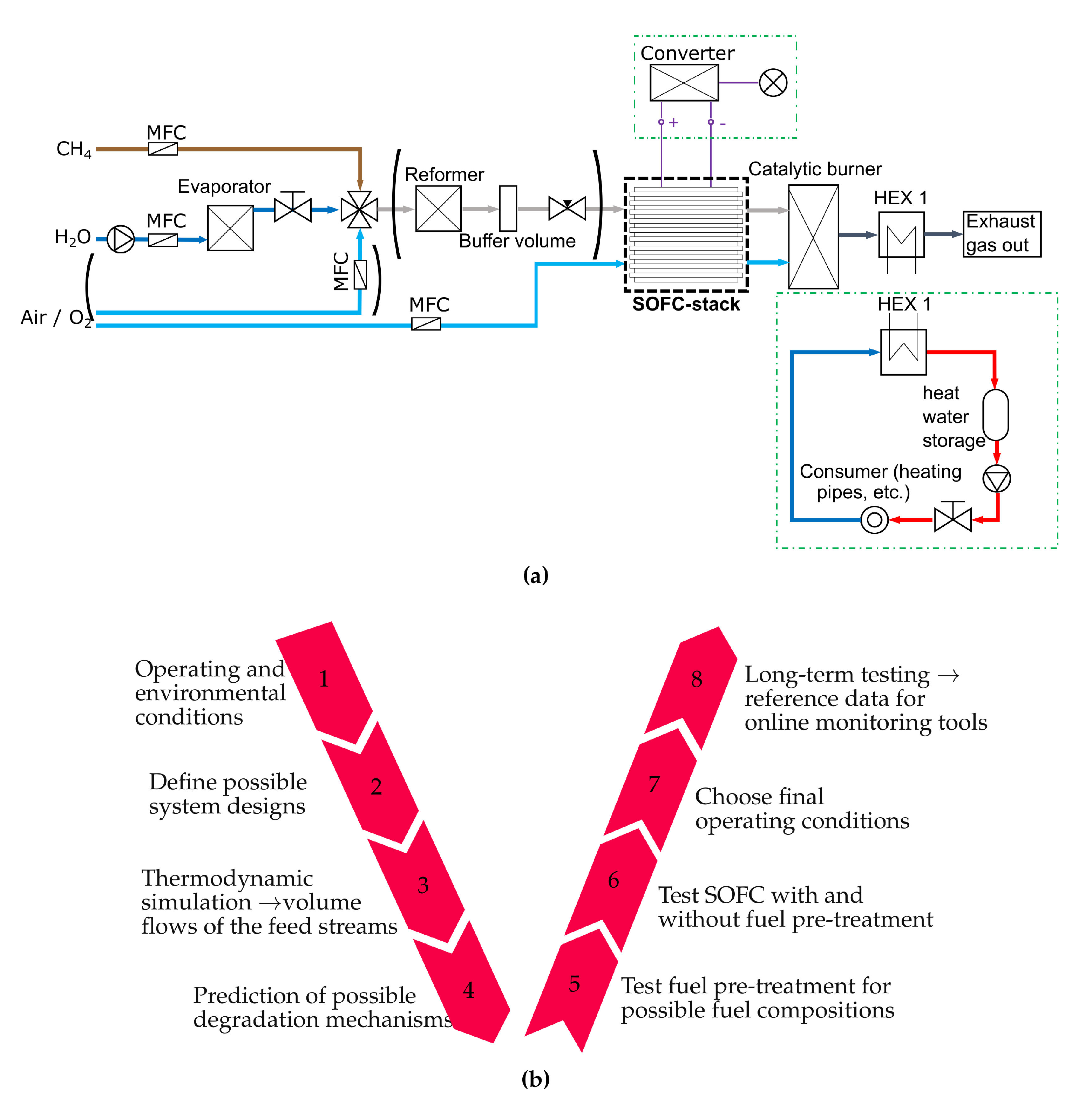
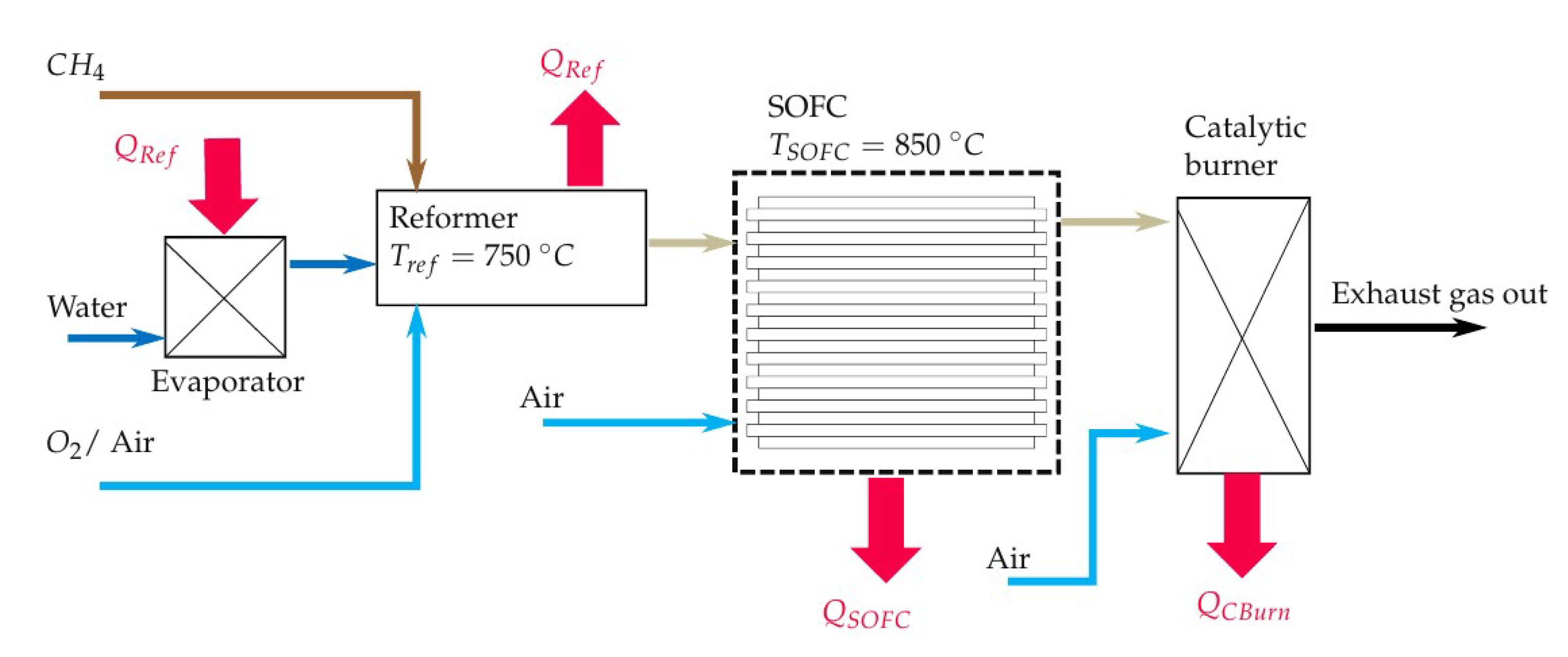
 , gas composition 2
, gas composition 2  , gas composition 3
, gas composition 3  , gas composition 4
, gas composition 4  , gas composition 5
, gas composition 5  , gas composition 6
, gas composition 6  .
.
 , gas composition 2
, gas composition 2  , gas composition 3
, gas composition 3  , gas composition 4
, gas composition 4  , gas composition 5
, gas composition 5  , gas composition 6
, gas composition 6  .
.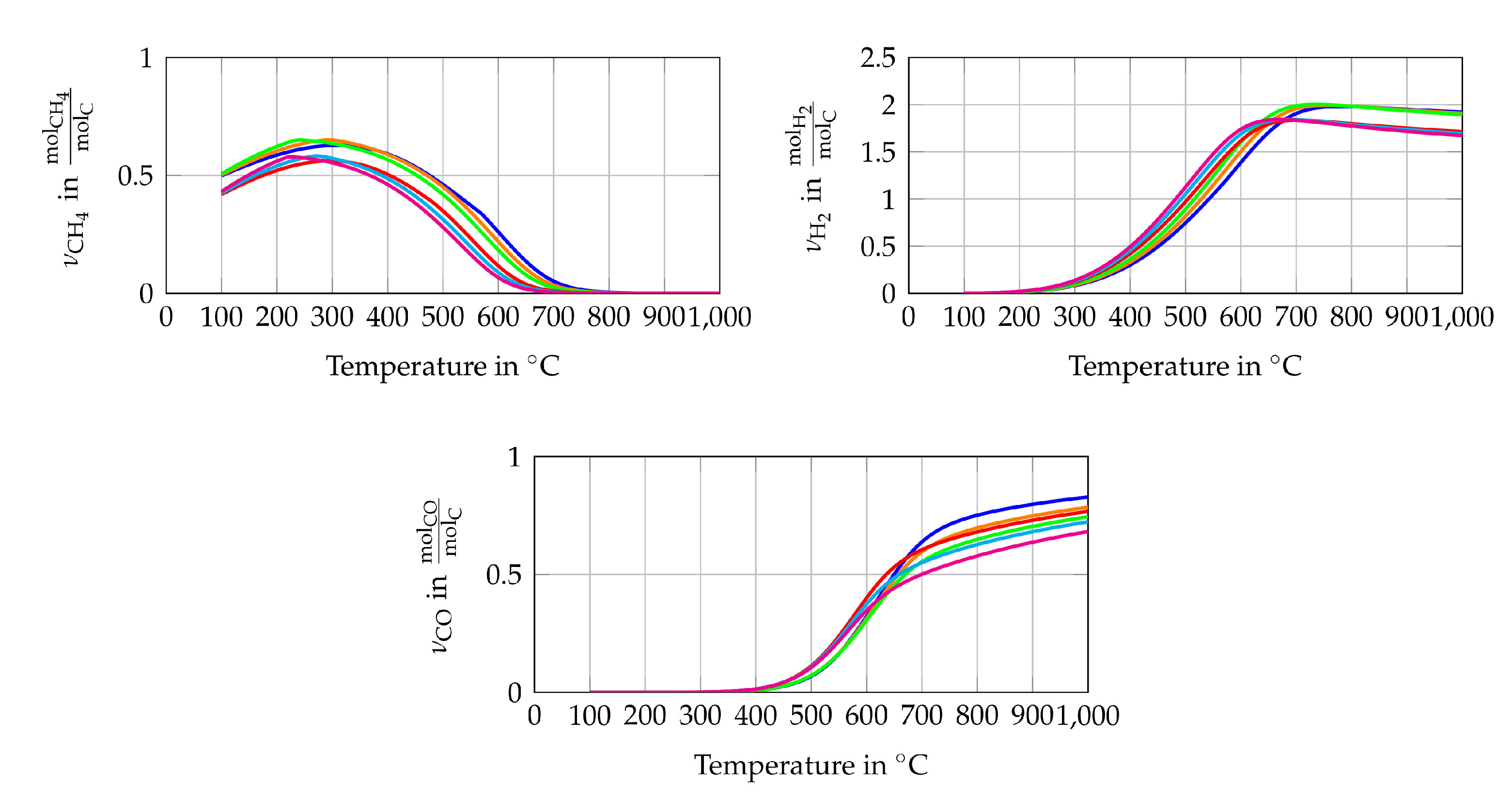
 , gas composition 2
, gas composition 2  , gas composition 3
, gas composition 3  , gas composition 4
, gas composition 4  , gas composition 5
, gas composition 5  , gas composition 6
, gas composition 6  , gas composition 7
, gas composition 7  , gas composition 8
, gas composition 8  , gas composition 9
, gas composition 9  , gas composition 10
, gas composition 10  .
.
 , gas composition 2
, gas composition 2  , gas composition 3
, gas composition 3  , gas composition 4
, gas composition 4  , gas composition 5
, gas composition 5  , gas composition 6
, gas composition 6  , gas composition 7
, gas composition 7  , gas composition 8
, gas composition 8  , gas composition 9
, gas composition 9  , gas composition 10
, gas composition 10  .
.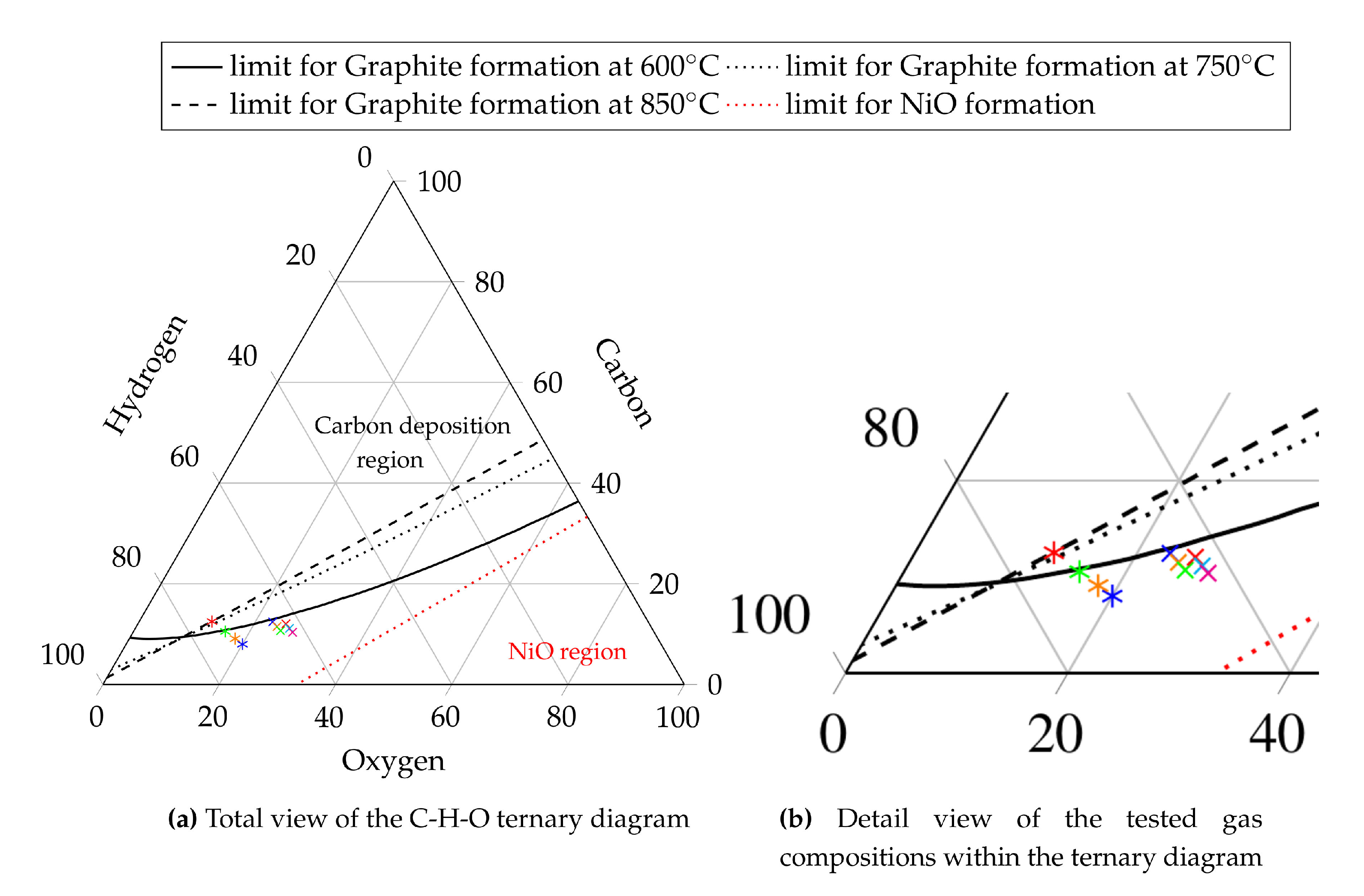
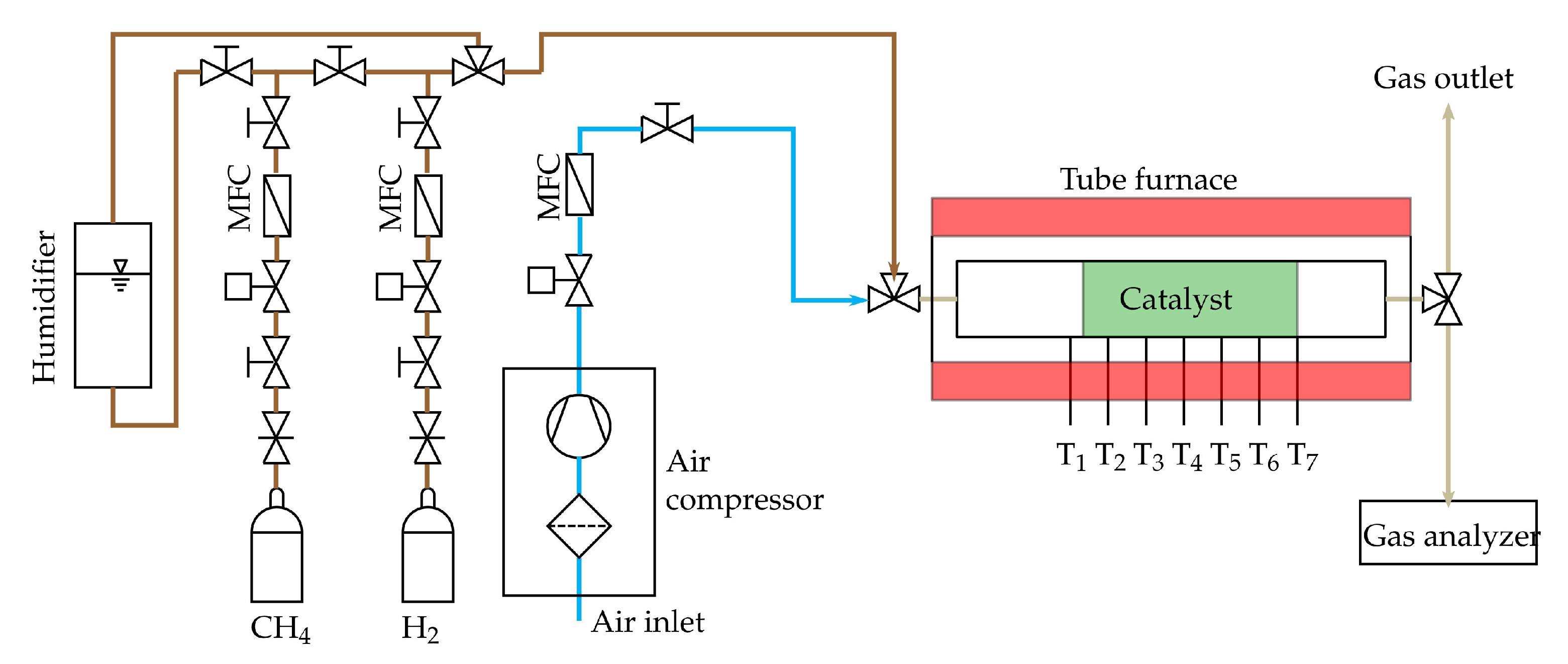

 , gas composition 2
, gas composition 2  , gas composition 3
, gas composition 3  , gas composition 4
, gas composition 4  , gas composition 5
, gas composition 5  , gas composition 6
, gas composition 6  , reformer simulation
, reformer simulation  .
.
 , gas composition 2
, gas composition 2  , gas composition 3
, gas composition 3  , gas composition 4
, gas composition 4  , gas composition 5
, gas composition 5  , gas composition 6
, gas composition 6  , reformer simulation
, reformer simulation  .
.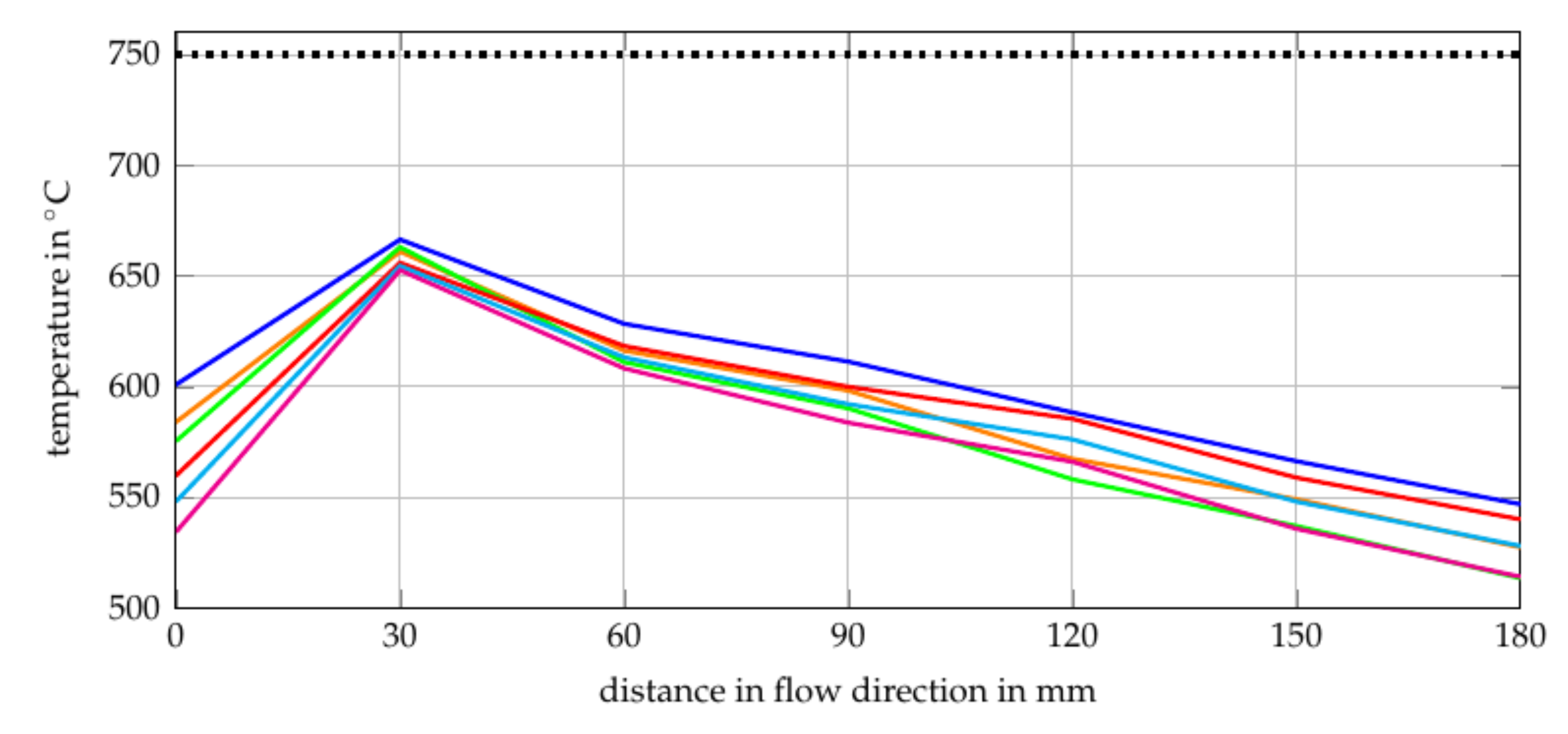
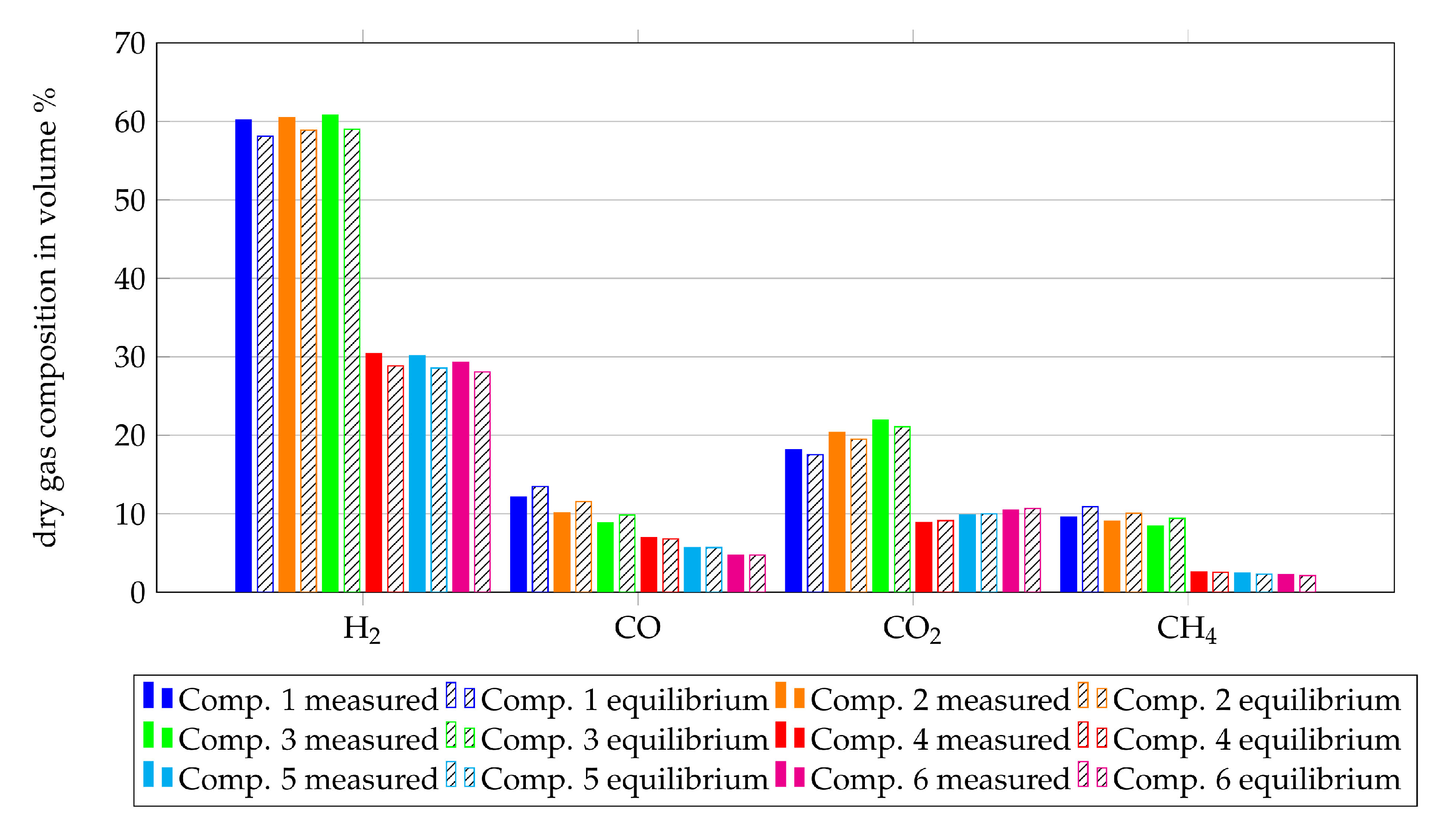
 , in the middle of the test series
, in the middle of the test series  and after the test series
and after the test series  . At the beginning of the internal reforming test series
. At the beginning of the internal reforming test series  , in the middle of the test series
, in the middle of the test series  and after the test series
and after the test series  .
.
 , in the middle of the test series
, in the middle of the test series  and after the test series
and after the test series  . At the beginning of the internal reforming test series
. At the beginning of the internal reforming test series  , in the middle of the test series
, in the middle of the test series  and after the test series
and after the test series  .
.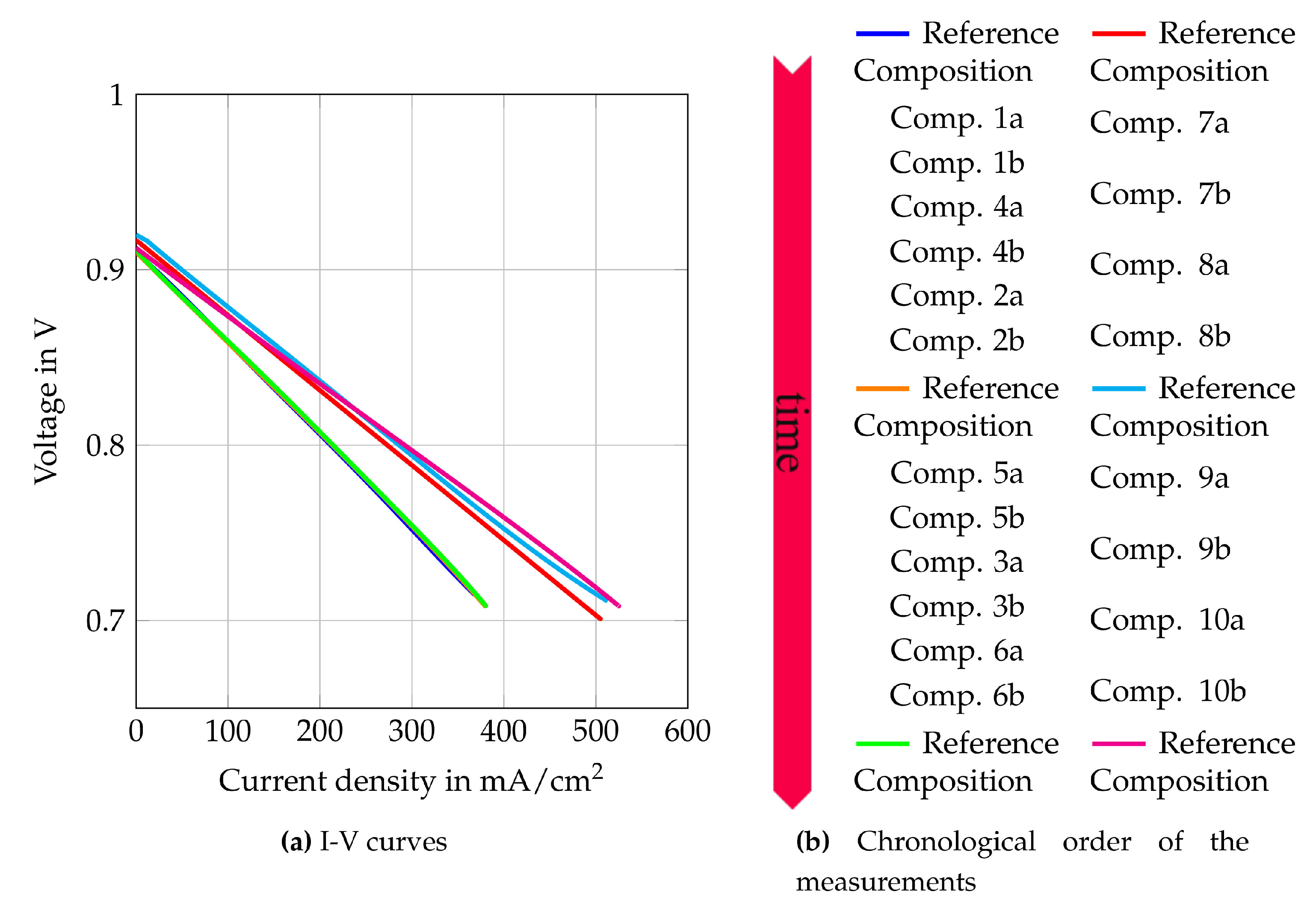
 , 2
, 2  , 3
, 3  , 4
, 4  , 5
, 5  , 6
, 6  , fuel use (dotted line) of Comp. 1
, fuel use (dotted line) of Comp. 1  , 2
, 2  , 3
, 3  , 4
, 4  , 5
, 5  , 6
, 6  and oxygen use (dashed line) of Comp. 1
and oxygen use (dashed line) of Comp. 1  , 2
, 2  , 3
, 3  , 4
, 4  , 5
, 5  , 6
, 6  for (gas compositions “a”) and (gas compositions “b”).
for (gas compositions “a”) and (gas compositions “b”).
 , 2
, 2  , 3
, 3  , 4
, 4  , 5
, 5  , 6
, 6  , fuel use (dotted line) of Comp. 1
, fuel use (dotted line) of Comp. 1  , 2
, 2  , 3
, 3  , 4
, 4  , 5
, 5  , 6
, 6  and oxygen use (dashed line) of Comp. 1
and oxygen use (dashed line) of Comp. 1  , 2
, 2  , 3
, 3  , 4
, 4  , 5
, 5  , 6
, 6  for (gas compositions “a”) and (gas compositions “b”).
for (gas compositions “a”) and (gas compositions “b”).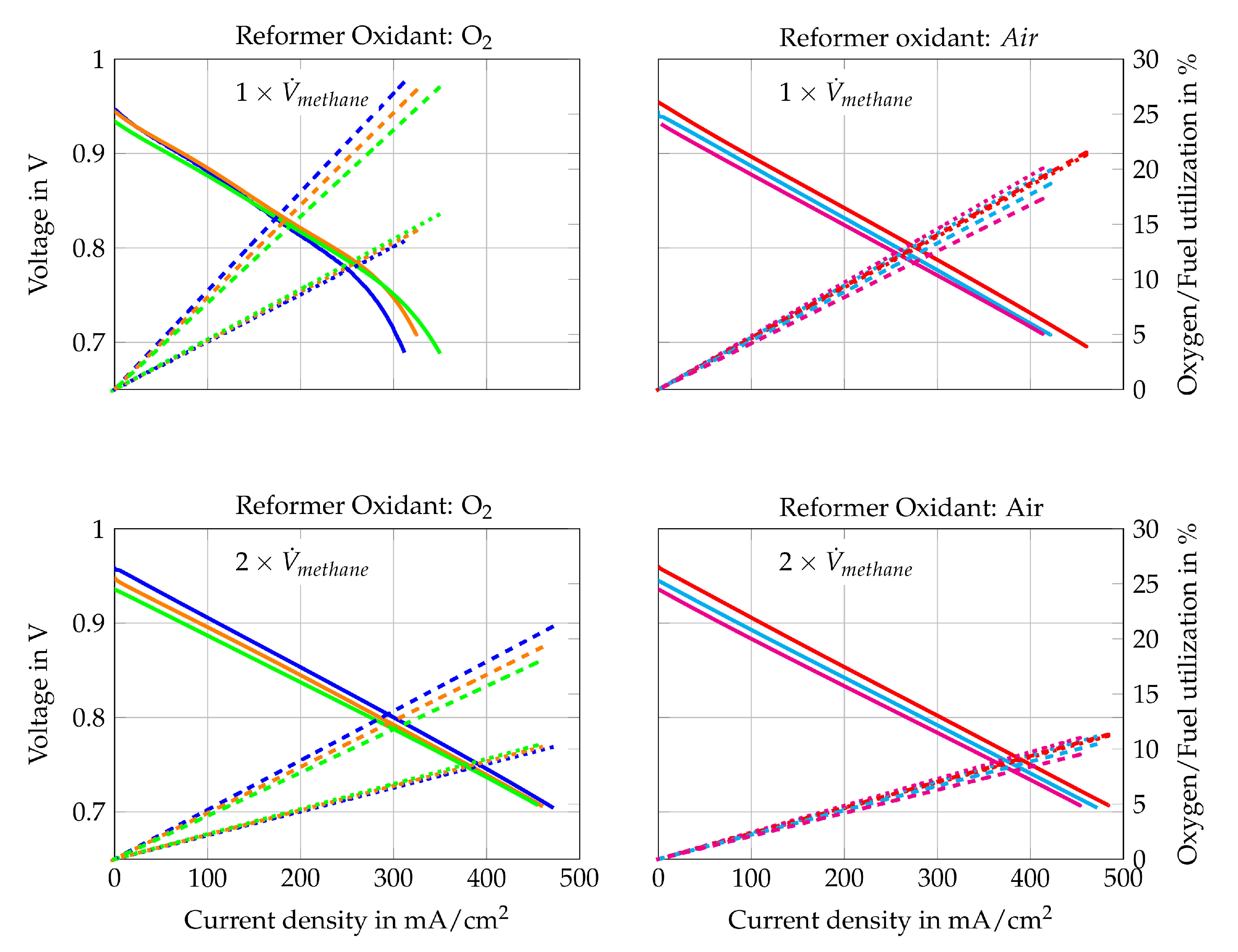
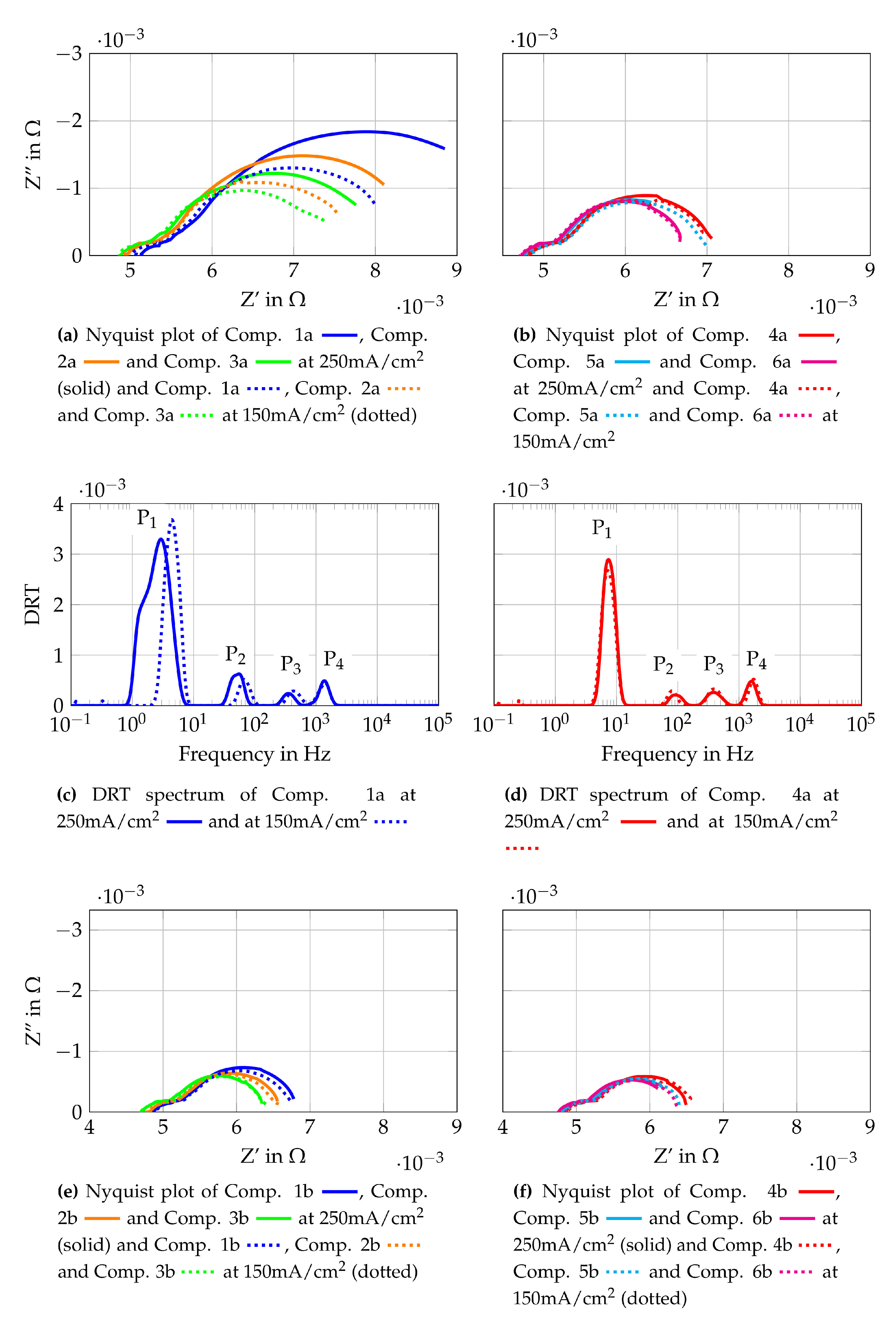
 , 8
, 8  , 9
, 9  , 10
, 10  , fuel use (dotted line) of Comp. 7
, fuel use (dotted line) of Comp. 7  , 8
, 8  , 9
, 9  , 10
, 10  and oxygen use (dashed line) of Comp. 7
and oxygen use (dashed line) of Comp. 7  , 8
, 8  , 9
, 9  , 10
, 10  for (Compositions “a”) and (Compositions “b”).
for (Compositions “a”) and (Compositions “b”).
 , 8
, 8  , 9
, 9  , 10
, 10  , fuel use (dotted line) of Comp. 7
, fuel use (dotted line) of Comp. 7  , 8
, 8  , 9
, 9  , 10
, 10  and oxygen use (dashed line) of Comp. 7
and oxygen use (dashed line) of Comp. 7  , 8
, 8  , 9
, 9  , 10
, 10  for (Compositions “a”) and (Compositions “b”).
for (Compositions “a”) and (Compositions “b”).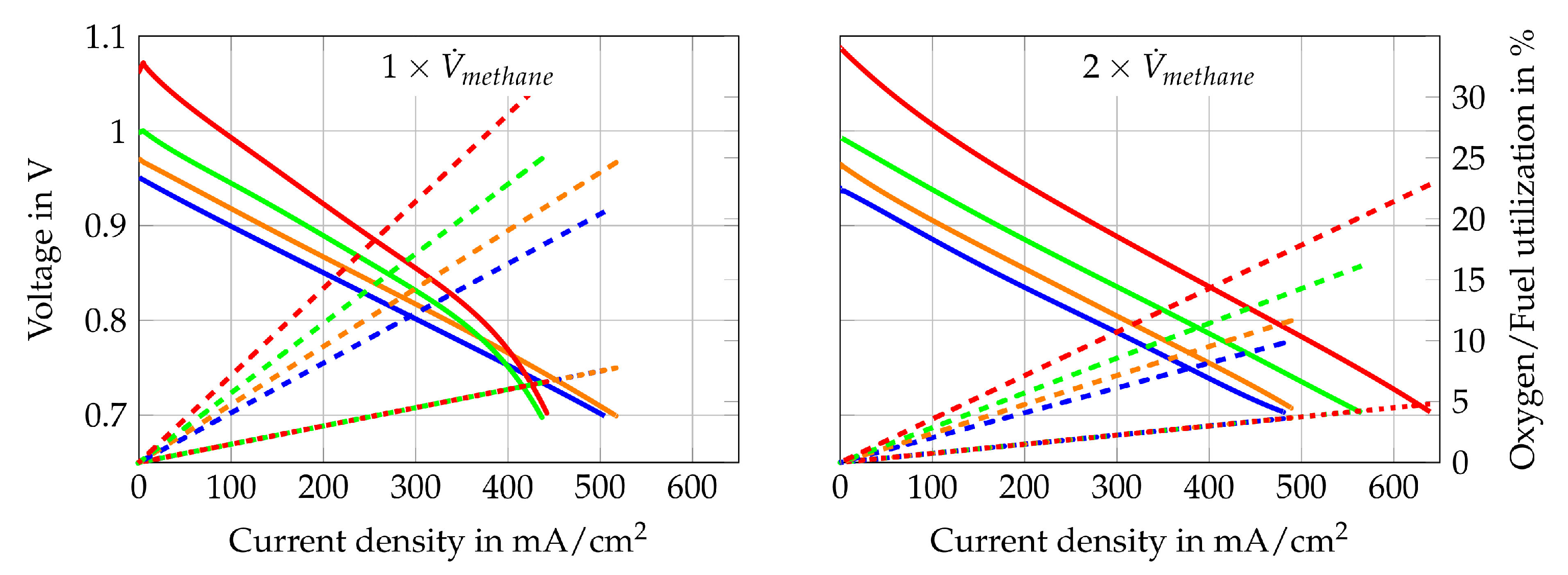
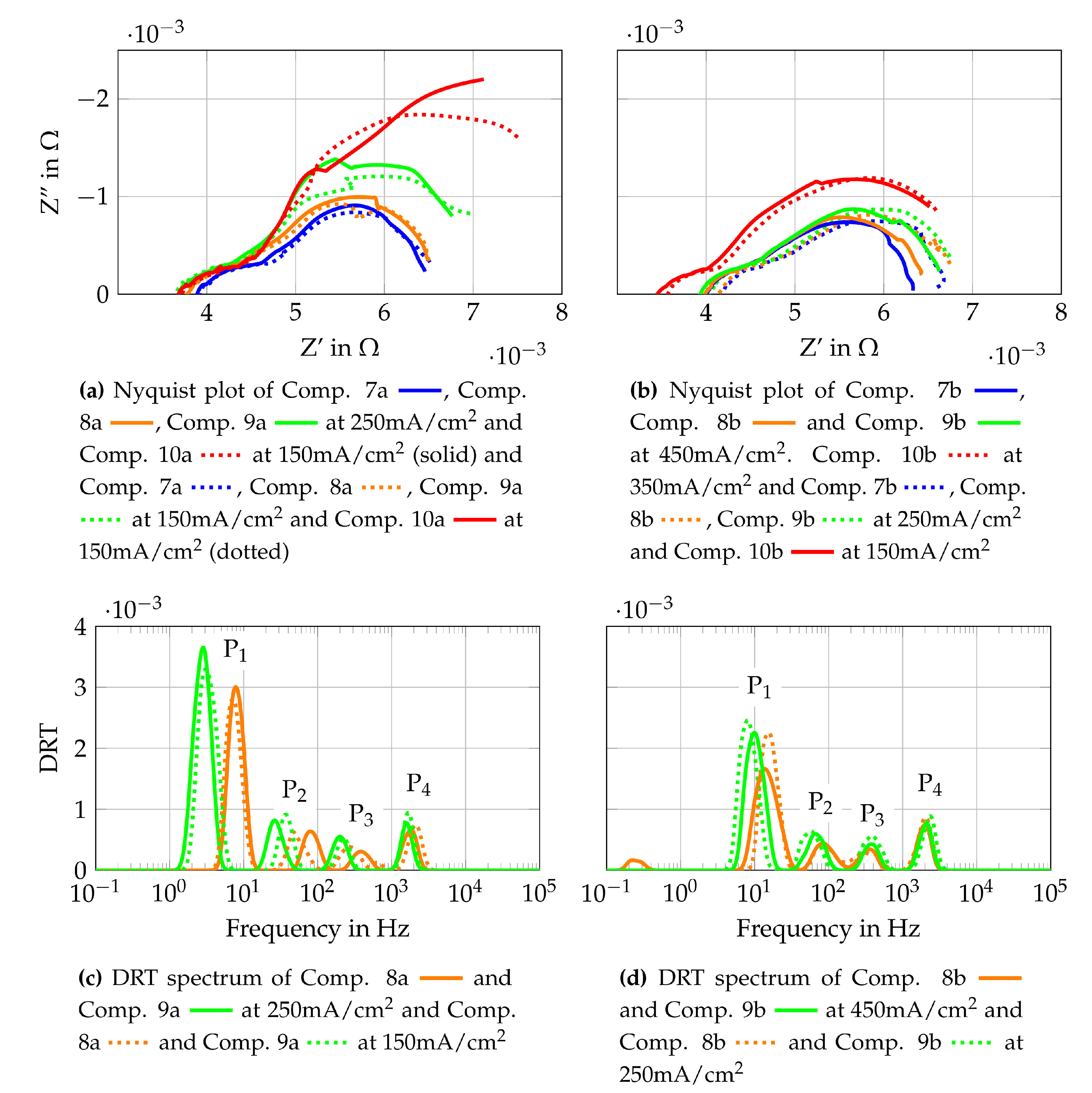
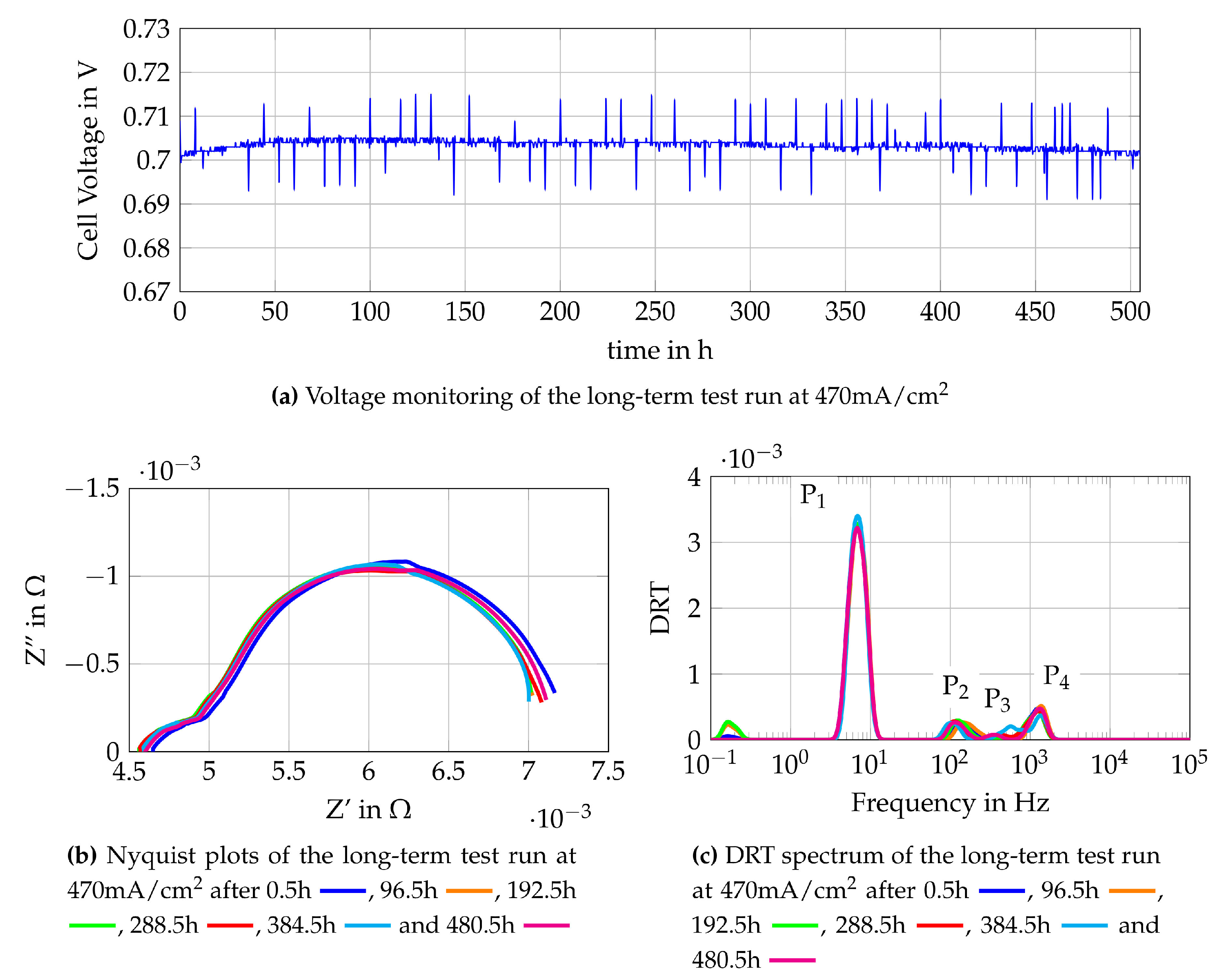
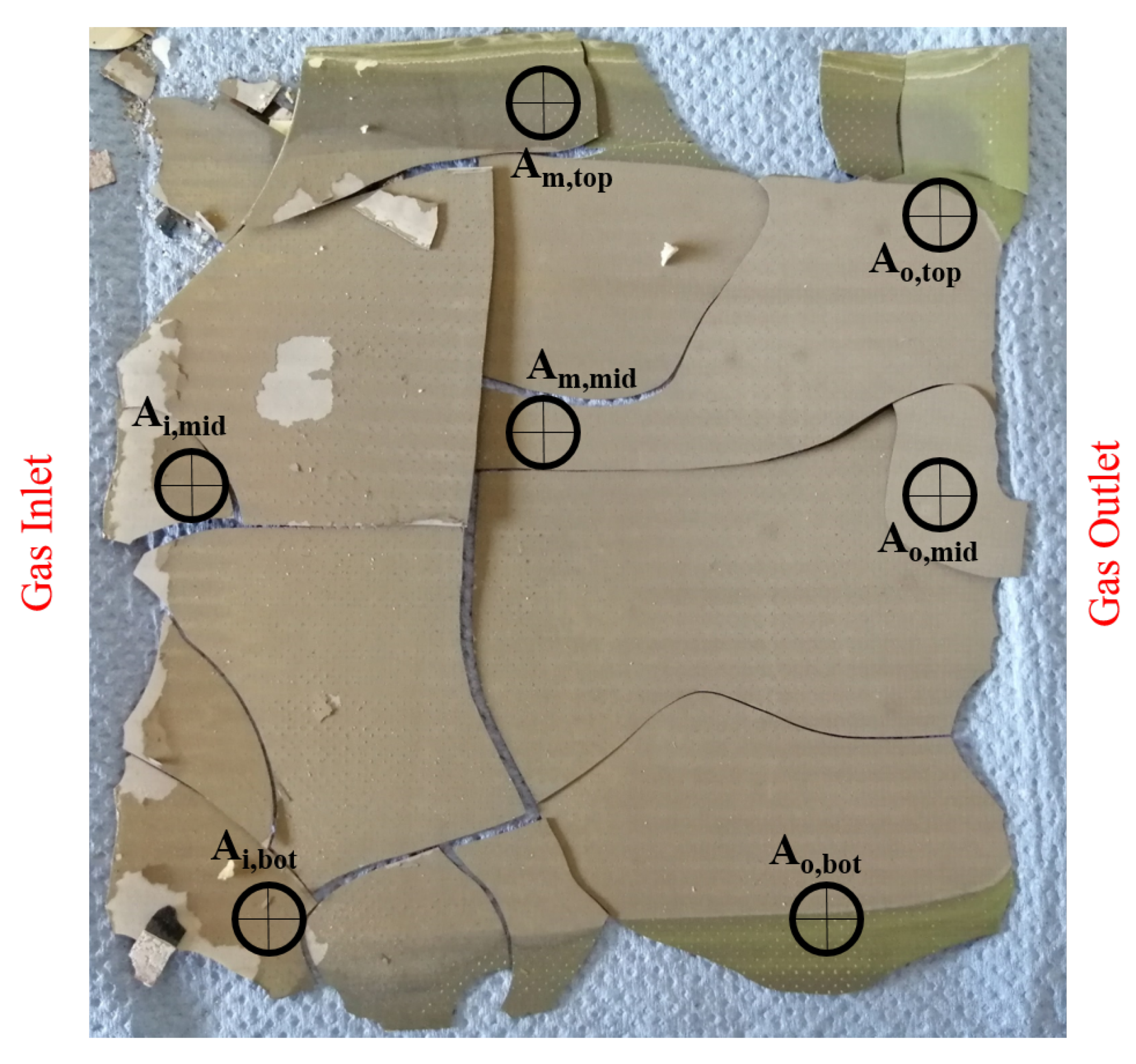


| Name | Inlet Temperatures | Inlet Pressures | Reformer Outlet Temperature | Reformer Oxidant | Volume Flow of CH4 | H2O/C | O/C |
|---|---|---|---|---|---|---|---|
| Unit | C | Bar Absolute | C | - | slpm | ||
| Comp. 1 | 25 | 1 | 750 | O | 0.8 | 0.6 | 0.63 |
| Comp. 2 | 25 | 1 | 750 | O | 0.8 | 0.8 | 0.65 |
| Comp. 3 | 25 | 1 | 750 | O | 0.8 | 1 | 0.68 |
| Comp. 4 | 25 | 1 | 750 | Air | 0.8 | 0.6 | 0.76 |
| Comp. 5 | 25 | 1 | 750 | Air | 0.8 | 0.8 | 0.79 |
| Comp. 6 | 25 | 1 | 750 | Air | 0.8 | 1 | 0.82 |
| Name | Gases Used on Anode Side | H2O/C | O2/C |
|---|---|---|---|
| Unit | - | ||
| Gas compositions used for auto-thermal reforming | |||
| Comp. 1 | CH, HO, O | 0.6 | 0.63 |
| Comp. 2 | CH, HO, O | 0.8 | 0.65 |
| Comp. 3 | CH, HO, O | 1.0 | 0.68 |
| Comp. 4 | CH, HO, Air | 0.6 | 0.76 |
| Comp. 5 | CH, HO, Air | 0.8 | 0.79 |
| Comp. 6 | CH, HO, Air | 1.0 | 0.82 |
| Gas compositions used for internal reforming | |||
| Comp. 7 | CH, HO | 2.5 | 0 |
| Comp. 8 | CH, HO | 2.0 | 0 |
| Comp. 9 | CH, HO | 1.5 | 0 |
| Comp. 10 | CH, HO | 1.0 | 0 |
| Name | SOFC Operating Temperature | CH4 | H2O | CO2 | H2 | CO | N2 | ||
|---|---|---|---|---|---|---|---|---|---|
| Unit | C | vol% | vol% | vol% | vol% | vol% | vol% | slpm | mol/min |
| Gas compositions obtained from auto-thermal reforming | |||||||||
| Comp. 1a | 850 | 7.5 | 21.2 | 14.3 | 47.4 | 9.5 | 0.0 | 1.500 | 0.021 |
| Comp. 1b | 850 | 7.5 | 21.2 | 14.3 | 47.4 | 9.5 | 0.0 | 3.000 | 0.042 |
| Comp. 2a | 850 | 6.7 | 25.8 | 15.1 | 44.9 | 7.5 | 0.0 | 1.606 | 0.021 |
| Comp. 2b | 850 | 6.7 | 25.8 | 15.1 | 44.9 | 7.5 | 0.0 | 3.212 | 0.042 |
| Comp. 3a | 850 | 5.9 | 29.8 | 15.4 | 42.7 | 6.2 | 0.0 | 1.711 | 0.021 |
| Comp. 3b | 850 | 5.9 | 29.8 | 15.4 | 42.7 | 6.2 | 0.0 | 3.422 | 0.042 |
| Comp. 4a | 850 | 2.3 | 11.0 | 7.9 | 27.1 | 6.2 | 45.6 | 2.873 | 0.021 |
| Comp. 4b | 850 | 2.3 | 11.0 | 7.9 | 27.1 | 6.2 | 45.6 | 5.747 | 0.042 |
| Comp. 5a | 850 | 2.1 | 13.5 | 8.5 | 26.1 | 4.9 | 44.9 | 3.035 | 0.021 |
| Comp. 5b | 850 | 2.1 | 13.5 | 8.5 | 26.1 | 4.9 | 44.9 | 6.070 | 0.042 |
| Comp. 6a | 850 | 1.9 | 15.9 | 8.8 | 24.6 | 4.0 | 44.8 | 3.208 | 0.021 |
| Comp. 6b | 850 | 1.9 | 15.9 | 8.8 | 24.6 | 4.0 | 44.8 | 6.417 | 0.042 |
| Gas compositions used for internal reforming tests | |||||||||
| Comp. 7a | 850 | 28.6 | 71.4 | 0.0 | 0.0 | 0.0 | 0.0 | 1.648 | 0.021 |
| Comp. 7b | 850 | 28.6 | 71.4 | 0.0 | 0.0 | 0.0 | 0.0 | 3.295 | 0.042 |
| Comp. 8a | 850 | 33.3 | 66.7 | 0.0 | 0.0 | 0.0 | 0.0 | 1.412 | 0.021 |
| Comp. 8b | 850 | 33.3 | 66.7 | 0.0 | 0.0 | 0.0 | 0.0 | 2.824 | 0.042 |
| Comp. 9 a | 850 | 40.0 | 60.0 | 0.0 | 0.0 | 0.0 | 0.0 | 1.177 | 0.021 |
| Comp. 9 b | 850 | 40.0 | 60.0 | 0.0 | 0.0 | 0.0 | 0.0 | 2.354 | 0.042 |
| Comp. 10 a | 850 | 50.0 | 50.0 | 0.0 | 0.0 | 0.0 | 0.0 | 0.941 | 0.021 |
| Comp. 10 b | 850 | 50.0 | 50.0 | 0.0 | 0.0 | 0.0 | 0.0 | 1.883 | 0.042 |
| Gas composition used for all single cell tests | |||||||||
| Reference Composition | 850 | 0.0 | 50.0 | 0.0 | 50.0 | 0.0 | 0.0 | 2.5 | 0.0 |
| Name | CH4 | H2O | CO2 | H2 | CO | N2 | at the Anode Side | at the Cathode Side | |
|---|---|---|---|---|---|---|---|---|---|
| Unit | Vol% | Vol% | Vol% | Vol% | Vol% | Vol% | slpm | slpm | mol/min |
| Comp. 8c | 33.3 | 66.7 | 0.0 | 0.0 | 0.0 | 0.0 | 1.412 | 2.824 | 0.021 |
Publisher’s Note: MDPI stays neutral with regard to jurisdictional claims in published maps and institutional affiliations. |
© 2021 by the authors. Licensee MDPI, Basel, Switzerland. This article is an open access article distributed under the terms and conditions of the Creative Commons Attribution (CC BY) license (http://creativecommons.org/licenses/by/4.0/).
Share and Cite
Höber, M.; Königshofer, B.; Wachter, P.; Nusev, G.; Boskoski, P.; Hochenauer, C.; Subotić, V. Holistic Approach to Design, Test, and Optimize Stand-Alone SOFC-Reformer Systems. Processes 2021, 9, 348. https://doi.org/10.3390/pr9020348
Höber M, Königshofer B, Wachter P, Nusev G, Boskoski P, Hochenauer C, Subotić V. Holistic Approach to Design, Test, and Optimize Stand-Alone SOFC-Reformer Systems. Processes. 2021; 9(2):348. https://doi.org/10.3390/pr9020348
Chicago/Turabian StyleHöber, Michael, Benjamin Königshofer, Philipp Wachter, Gjorgji Nusev, Pavle Boskoski, Christoph Hochenauer, and Vanja Subotić. 2021. "Holistic Approach to Design, Test, and Optimize Stand-Alone SOFC-Reformer Systems" Processes 9, no. 2: 348. https://doi.org/10.3390/pr9020348
APA StyleHöber, M., Königshofer, B., Wachter, P., Nusev, G., Boskoski, P., Hochenauer, C., & Subotić, V. (2021). Holistic Approach to Design, Test, and Optimize Stand-Alone SOFC-Reformer Systems. Processes, 9(2), 348. https://doi.org/10.3390/pr9020348







